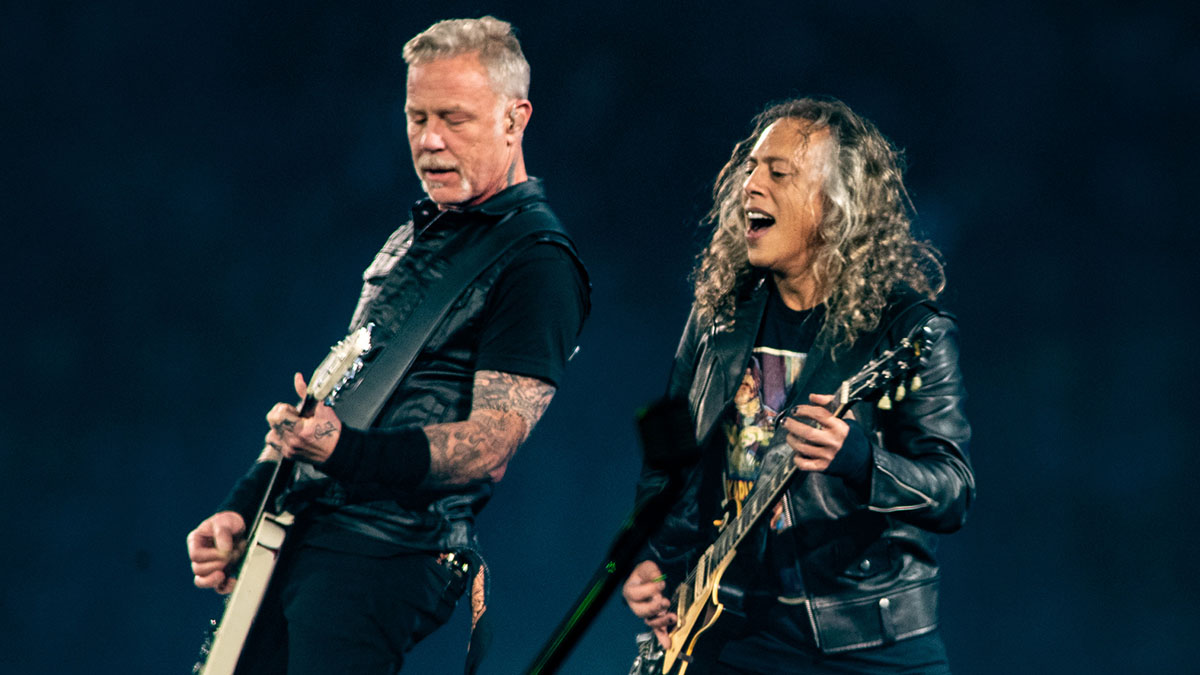
James Hetfield and Kirk Hammett have been kicking heavy metal ass for 40 years. In 1983, it was the band’s mission statement, with their debut album originally planned to be titled Metal Up Your Ass until Kill ’Em All eventually stuck. And if their debut set the scene for the burgeoning thrash metal genre, their next three albums defined it until 1991, when their self-titled ‘Black Album’ sent the band to the stratosphere, hitting number 1 worldwide.
Like most guitar bands who reach their fifth decade, Metallica’s back catalogue offers a wealth of riches for any six-string slinger on a mission to play better. The Phrygian and Aeolian modes are core harmonic essentials, with powerchords and downpicking techniques appearing in almost every song the band have ever recorded.
But emulating their style is far from simple. Dual-harmony guitar lines are often more complex than mere 3rd- and 4th-interval affairs, and syncopated riffs at fearsome tempos provide serious technical workouts.
For now, plug in, crank up the gain and let’s look at Hetfield and Hammett’s most important techniques, as employed from their ’83 debut right up to this year’s 72 Seasons. Wah pedal optional. Downpicking is essential!
Example 1. Powerchords and gallops

We’re taking inspiration from 1984’s Fight Fire With Fire and the title track from the band’s latest release 72 Seasons here.
Use alternate picking and palm-muting to play the open sixth string, but lift your palm away from the strings for the powerchords. Strum these with downstrokes and use slides to shift between them where indicated.
Example 2. Slow stomping syncopation

Here we’re showcasing the pull-off technique of Sad But True and the stomping syncopation of this year’s You Must Burn. In bar 1, your aim is to sound only one note at a time, so make sure to mute each open string after you’ve played it.
For bar 2, it’s all about space. The syncopation comes from hitting those powerchords on the offbeat while staying dead silent in the gaps.
Example 3. Hit the powerchords

This riff demonstrates the kind of two-note powerchord shapes on display in tracks such as Hit The Lights, albeit in F# minor here. Play the doublestop shapes with a first finger barre followed by your third and fourth fingers together. Turn your hand from the wrist for the semitone bend and release.
Example 4. Battery-style gallop

Use tight palm-muted picking to play the Battery-style galloping rhythm on the sixth string here. This is played with a combination of downpicking for the eighth notes and alternate picking for the faster 16ths. Use the tip of the pick to glide across the string for a consistent tone, and don’t pick too hard.
Example 5. Justice-style blues scale soloing

Kirk is a fan of soloing with the blues scale – and we’re channelling ...And Justice For All along with new track Shadows Follow here in a scalic line played along the first string. For our repeating four-note phrase, use a downstroke followed by a pull-off, then pick ‘down-up’. Pull off with your first finger as you move up and down the neck.
Example 6. Classic Hammett repeating lick

This repeating lick is a staple Hammett phrasing idea, appearing in one form in Enter Sandman and being reinvented recently in Too Far Gone.
Play the repeating lick with a third-finger bend/release, pull off to your first finger, then finish with your third finger on the fourth string. This repeat is three beats long, but when played against the 4/4 drumbeat an interesting displacement happens.
Example 7. Heavy harmonies

Harmony guitar parts have featured heavily in Metallica’s recorded output, from 1984’s Fade To Black, to 2016’s Atlas Rise and new album track Inamorata. Our lick here is the higher part of a two-guitar harmony in E minor (E F# G A B C D). Listen to the guitar on the backing track to match the timing and intensity so the guitars blend as one.
Example 8. Triplet-phrased leads

Recent single If Darkness Had A Son is our inspiration here as we home in on some repeating three-note phrases in bar 3. Use your third, second and first fingers respectively, picking each 15th fret G note before pulling off to the 14th (F#) and 12th frets (E). Take care with the rhythm. Unusually, nine notes cover half a bar here.
Example 9. James-style downpicking

This riff is based on Heftield’s legendary downpicking technique which he uses in eighth-note riffs around the 200bpm mark in Master Of Puppets and Blackened. Use your wrist to bounce the pick off of the string and keep your arm relaxed so as to maintain the movement for long periods.
Your arm may feel more relaxed when straighter, so try playing in a standing position with your guitar slung low.
Example 10. Shape 1 Pentatonics

Kirk’s soloing style draws heavily on pentatonics – and our lick here is the kind you’ll hear in everything from Hit The Lights to Room Of Mirrors. It’s a simple pull-off idea played on the two highest strings. Try adapting our lick through any two-note-per-string E minor pentatonic scale shape.







